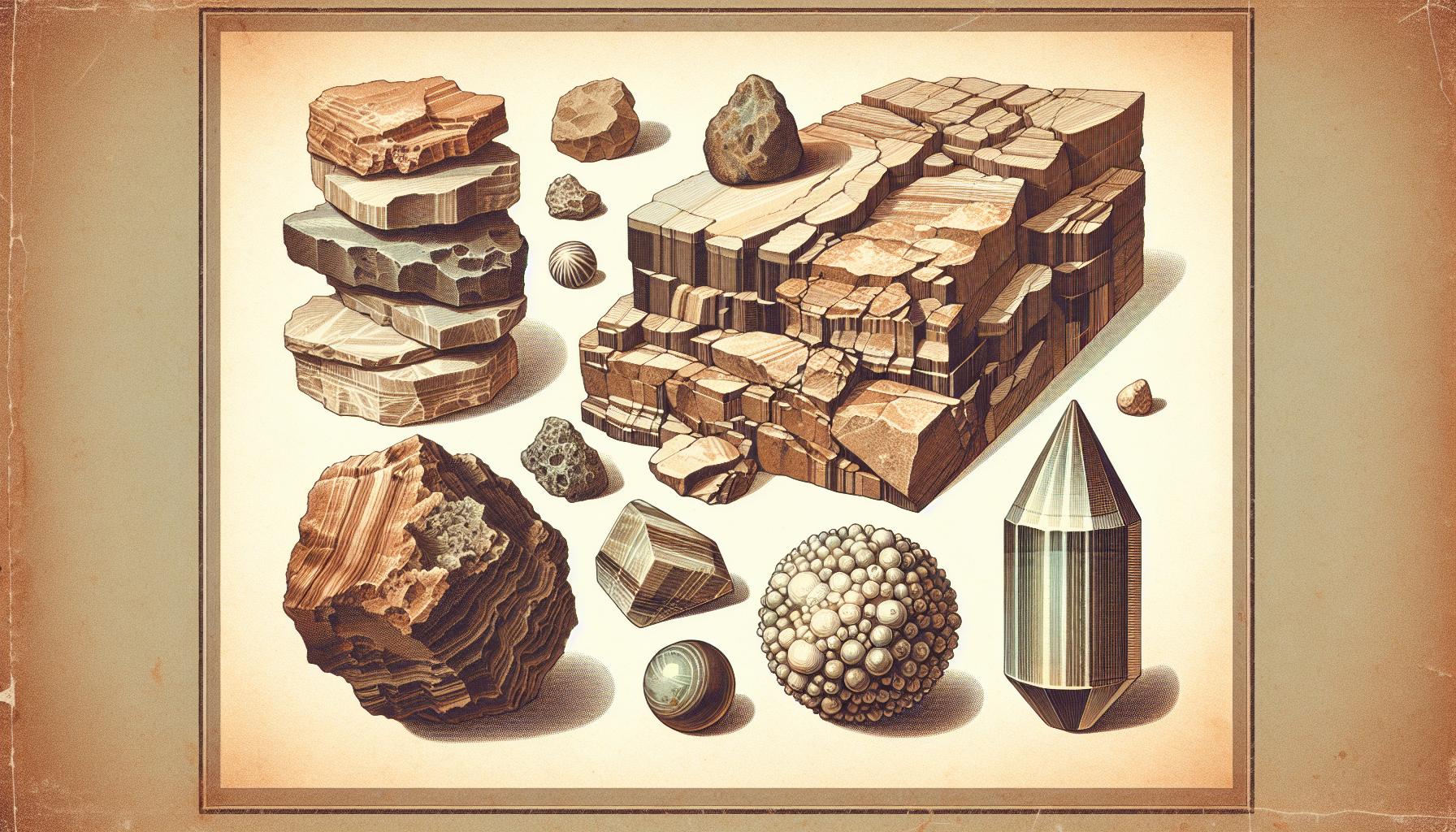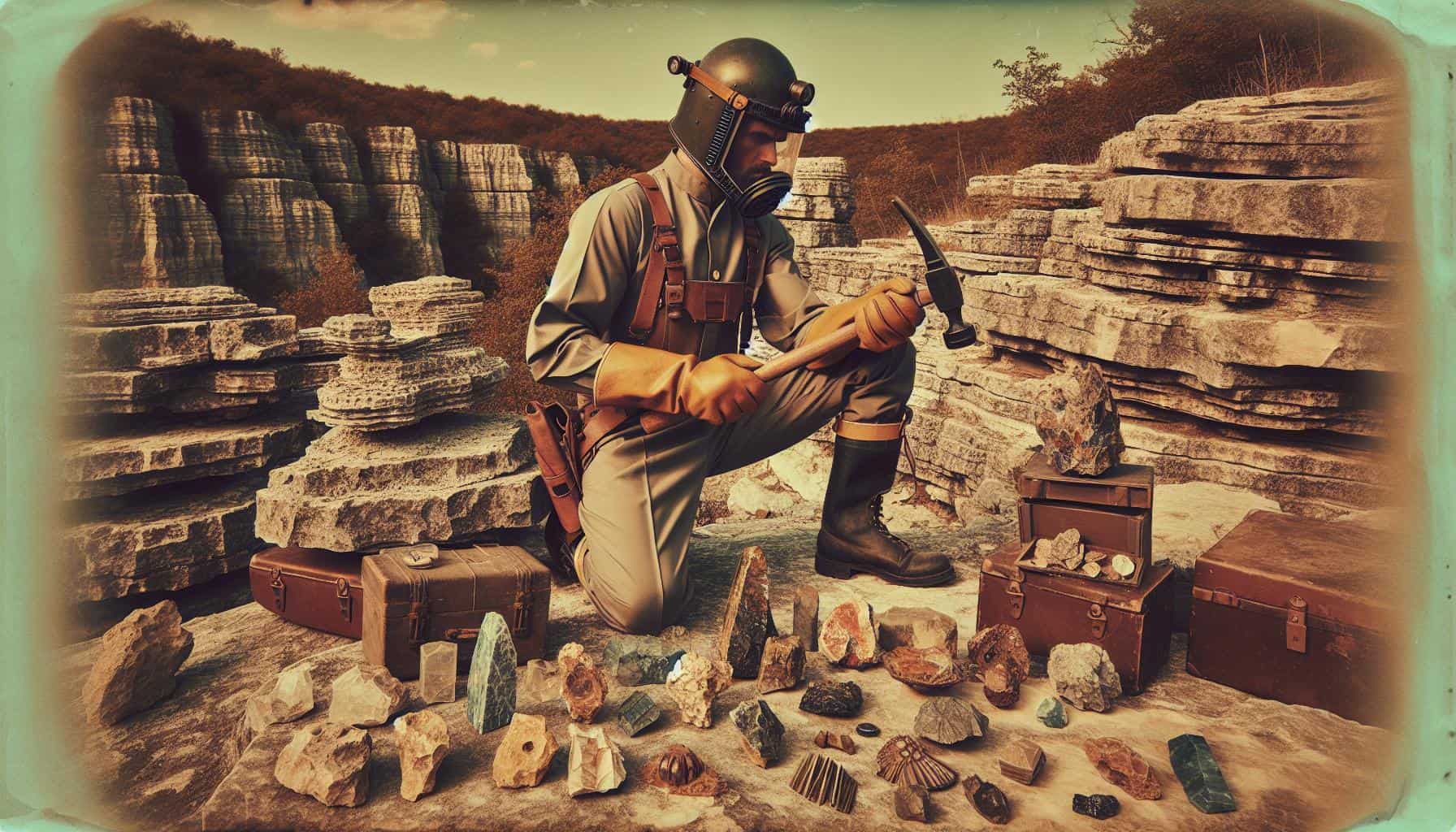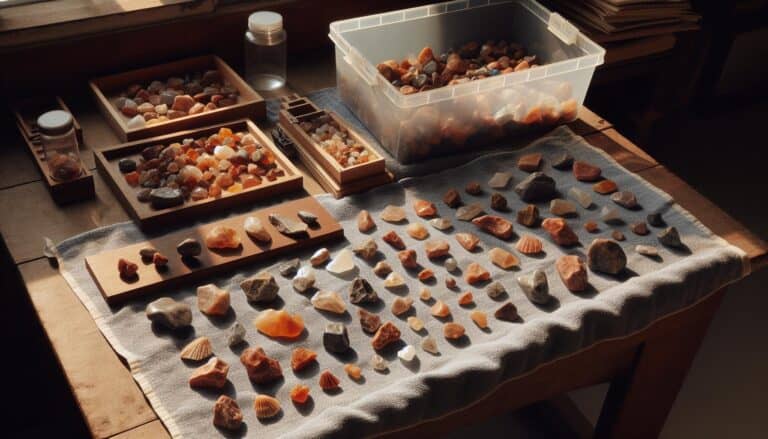Arkansas, often dubbed the Natural State, is a rockhound’s paradise with its abundant and diverse geological treasures.
Whether you’re an experienced collector or just starting, you’ll find Arkansas’s landscape dotted with opportunities to uncover crystals, gemstones, and fossils.
In Arkansas, prime rockhounding locations include Crater of Diamonds State Park for diamonds, Ouachita Mountains for quartz crystals, Mount Ida for quality quartz, Sweet Surrender Crystal Mine for high-quality quartz, and Coleman Miller Mountain Mine for wavellite. Respect land and regulations for a rewarding experience.
Arkansas Rockhounding Locations
Arkansas boasts a plethora of sites well-suited for rockhounding; each location offers a unique set of minerals and crystals that’ll tempt any enthusiast. One can’t discuss Arkansas rockhounding without mentioning the Crater of Diamonds State Park. As the only public diamond-bearing site in the world, you can dig for real diamonds here, and what’s more, you get to keep any gem you find.
- Crater of Diamonds State Park – Search for diamonds
- Ouachita Mountains – Uncover quartz crystals
- Mount Ida – Known as the Quartz Crystal Capital of the World
- Sweet Surrender Crystal Mine – Find quality quartz
In the Ouachita Mountains, renowned for vast quartz crystal deposits, the digging sites allow you to pay a fee and keep all that you discover. Mount Ida, in particular, earns its nickname as the Quartz Crystal Capital of the World due to its abundant crystal veins and mines that are open to the public. Whether it’s a pocket full of quartz or finding clusters, the Mount Ida area is a must-visit.
For those who prefer a more guided experience, the Sweet Surrender Crystal Mine offers the chance to find high-quality quartz with the help of experienced miners. You‘ll learn the ropes of what makes a valuable find and how to spot the best pieces hidden away in the earth.
Another noteworthy spot is the Coleman Miller Mountain Mine, where enthusiasts can dig for a treasure trove of minerals like wavellite, which is peculiar to this region. You won’t need to bring your tools as they are available for rent on-site.
Remember, while you‘re out there finding natural treasures, it’s important to always respect the land and regulations set by the mines and parks. Happy rockhounding!
| Location | Notable Finds |
|---|---|
| Crater of Diamonds State Park | Diamonds |
| Ouachita Mountains | Quartz Crystals |
| Mount Ida | Quartz Crystals |
| Sweet Surrender Crystal Mine | High-Quality Quartz |
| Coleman Miller Mountain Mine | Wavellite |
Whether you‘re looking to add to your collection or just seeking an adventurous day out, Arkansas’s rockhounding locales are sure to offer an unforgettable experience.
What Gemstones are Found in Arkansas?

Arkansas is a wellspring of precious gemstones, each nestled in the state’s rich geology, offering an adventure for rockhounders like you. Not only can one find diamonds at the renowned Crater of Diamonds State Park, but Arkansas is also a veritable trove of other precious and semi-precious stones.
Among these treasures, you’ll find quartz crystals, particularly abundant in the Ouachita Mountains. These immaculate specimens, often clear and sometimes smoky in color, are coveted by collectors worldwide. The Mount Ida region, especially, has gained a reputation for producing some of the finest quartz crystals, rated high for both size and clarity.
But the bounty doesn’t stop at quartz. Jasper, a form of chalcedony, is another gemstone that can be unearthed in Arkansas. With its earth-toned colors and intricate patterns, it’s a favorite for lapidary arts. Agates, too, are found here, displaying their signature bands of color that make each piece unique.
One of the more intriguing finds is the wavellite, which you might encounter at the Coleman Miller Mountain Mine. This mineral, characterized by its green, radial cluster formations, is not only a rare find but also a photogenic subject for mineral enthusiasts.
Let’s not overlook the potential for finding opals, garnets, and even peridot in the state. While these finds are less common, the thrill of uncovering them amidst the ordinary rocks can be exceptionally rewarding.
Below is a table summarizing the gemstones commonly found in Arkansas:
| Gemstone | Locations | Notable Characteristics |
|---|---|---|
| Quartz Crystal | Ouachita Mountains, Mount Ida | Clear, sometimes smoky |
| Jasper | Various sites across the state | Earth-toned, patterned |
| Agate | Scattered locales | Banded colors |
| Wavellite | Coleman Miller Mountain Mine | Green, radial clusters |
| Opals | Rare occurrences | — |
| Garnets | Sporadic finds | — |
| Peridot | Rarely found | — |
What Sedimentary Rocks You Can Find in Arkansas?

As you explore Arkansas’s varied geology, you’ll discover that the state is not just a treasure trove of gemstones but also a rich repository of sedimentary rocks. These rocks tell tales of ancient seas, rivers, and deltas that once covered the land.
Limestone is abundant in the Ozark Plateau region of northern Arkansas. Formed from the skeletal fragments of marine organisms such as coral and mollusks, limestone in this area is a testament to the marine environments of ancient geological periods. Not only is limestone revered for its fossil records, but it’s also sought after for its uses in construction and agriculture.
Heading south into the Arkansas River Valley, sandstone often takes the spotlight. This gritty-textured rock, comprised mostly of sand-sized mineral particles or rock fragments, varies in color from tan to reddish-brown, reflecting the iron oxide that binds the grains together. Sandstone is valued for its durability and has been used extensively in building and paving.
Within this same region, you may also stumble upon shale. Shale is a fine-grained sedimentary rock formed from silt and clay that settled in low-energy environments like floodplains or the deep ocean. Often found in layers, shale can range in color from gray to black and sometimes contains fossils of plants and small creatures that once thrived in prehistoric wetlands.
Let’s not overlook chalcedony, a cryptocrystalline form of silica, found in the form of nodules in limestone deposits. Thanks to its variety of colors and patterns, chalcedony is a favorite among rock collectors and jewelers alike.
When you’re scanning the ground for these sedimentary delights, remember that Arkansas’s geological variety extends far beyond precious gemstones. Each piece of sedimentary rock you find is a page from Earth’s dynamic history, waiting for you to read its story.
What Metamorphic Rocks are found in Arkansas?
Metamorphic rocks, a testament to nature’s alchemy, transform under intense heat and pressure within the Earth’s crust. In Arkansas, your rockhounding adventure may lead you to discover such geological treasures.
Arkansas’s own Quartzite is a metamorphic rock that primarily originates from sandstone. Found in the Ouachita Mountains, quartzite here is often associated with the region’s past geological activity. Its high resistance to weathering makes it a common find on ridges and steep slopes, revealing its eroded glossy surface in a range of colors from white to gray.
Marble is another metamorphic rock present in Arkansas, particularly in the vicinity of Magnet Cove, Hot Spring County. Originally limestone or dolostone, the intense geological processes have recrystallized its carbonate minerals. While not as commonly seen as quartzite, Arkansas marble is prized for its appearance and variety, with colors spanning from pure white to dramatic swirls of green and black.
Slate often heralds from the regions where shale was once prevalent. The Arkansas Valley is home to this fine-grain metamorphic rock, where it’s traditionally been used in roofing materials due to its natural cleavage into flat sheets. The color palette of Arkansas slate can be quite vibrant with shades of green, red, and purple, depending on the minerals present during its formation.
The complexity of Arkansas’s geology is further exemplified by rocks like Novaculite. This unique, dense stone has a rich history, having been used by Native Americans for making tools and weapons and is still utilized for whetstones today. The Washita Mountains and the Ouachita Mountain regions are known hotspots where you might stumble across this historically significant rock.
In search of these metamorphic marvels, ensure to respect natural habitats and private property. Always remember that the true value of rockhounding lies not solely in the finds but in the fascinating geological stories they tell.
What Igneous Rocks can You Find in Arkansas?
While your rockhounding adventure in Arkansas is likely peppered with sightings of stunning metamorphic specimens, don’t overlook the variety of igneous rocks that also adorn the landscape. These formed from the cooling and solidification of magma or lava and hold a fascinating piece of the earth’s fiery past.
At the heart of Arkansas’s igneous formations is the town of Magnet Cove, recognized for an area steeped in geological diversity. Syenite, a coarse-grained igneous rock, is abundant here. Notably, Magnet Cove’s syenite is associated with an array of rare minerals and boasts a significant concentration of titanium ore. Another eye-catching feature of this syenite is the presence of nepheline, giving it a unique texture that’s both a curiosity and a collector’s delight.
As you meander through the Ouachita Mountains, keep an eye out for lamproite, distinctive for its dark coloration and rich greenish-black tinges. Arkansas is one of the few places in the world where you can find this volcanic rock which is famously associated with diamonds at the Crater of Diamonds State Park. Yes, you read that right—diamonds in Arkansas! These diamonds occur naturally and the park allows visitors to search for them, adding an exciting edge to your rockhounding expedition.
Beyond these well-known finds, Arkansas’s igneous rocks also include varieties of pumice, rhyolite, and basalt. Pumice has a frothy appearance and is light enough to float on water, while rhyolite displays a spectrum of colors and patterns due to its high silica content. Basalt, found in fewer locations, forms from quick-cooling lava and has a fine-grained structure.
Keep in mind that while on your quest for these igneous treasures, identifying the exact location of these rocks requires detailed maps and sometimes, the permission of landowners. Always ensure you’re in compliance with local rockhounding regulations and stay informed about which areas are open to the public. With a little patience and the right tools, you’re set to uncover pieces of earth’s fiery core right in Arkansas.
Panning for Gold in Arkansas
While Arkansas may not be the first state you think of for gold panning, it’s a quietly popular activity for enthusiasts and hobbyists alike. The Ouachita Mountains have been a historic hotspot for gold prospectors. Streams flowing out of the mountains are considered favorable for panning.
The Ouachita River and its tributaries, especially the Little Missouri River, have garnered a reputation for modest gold finds. When panning in these areas, you’re looking for placer gold – tiny flecks and nuggets washed down from the erosion of rocks. Temporarily set your expectations for monumental finds aside, as Arkansas gold is often fine and flour-like.
Key Spots for Gold Panning
- The Caddo River – Known for its recreational use, this river also holds opportunities for panning. Gold is typically finer here but patience may pay off.
- The Saline River – This location offers a scenic backdrop to gold panning efforts. Work gravels in and around the water, keeping a keen eye for specks of color.
Before heading out, remember to research land ownership. Public lands may allow panning, but some areas require permits. Always respect private property by obtaining permission beforehand.
Essential Gold Panning Tips
To increase your chances of success in Arkansas, try these tips:
- Early spring or late winter is the best time to pan after floodwaters have potentially unearthed new deposits.
- Use a classifier to sift larger rocks and debris from your potential gold-bearing gravel.
- Focus on areas where heavier materials like gold would settle, such as bends in the river or the downstream side of boulders.
Keep in mind that Arkansas’s gold deposits are mostly very fine, so specialized equipment, such as a sluice box and a fine gold recovery unit, may enhance your gold panning experience. Regardless of the yield, gold panning in Arkansas is a relaxing way to connect with nature while engaging in a historic pastime.
Rocks and Minerals Found in Arkansas
As you explore Arkansas’s geological panorama, you’ll uncover a veritable treasure chest of rocks and minerals. The state’s diverse landscape offers more than just the novice rockhound’s commonly sought-after quartz. Arkansas is a hub for mineral enthusiasts, with a wealth of natural resources.
Quartz, the state mineral, is undoubtedly a star attraction. Arkansas quartz can be found in stunning clarity and variety, from transparent, colorless specimens to smoky crystals. The renowned quartz mines of Mount Ida and the surrounding Montgomery County are key destinations where you can dig for your own natural treasures.
Beyond quartz, you’re likely to find a range of fascinating minerals:
- Wavellite: Known for its distinctive green radial clusters and found in the Ouachita Mountains.
- Brochantite: A rare copper sulfate mineral known for its brilliant green color.
- Galena: This lead sulfide mineral, with its shiny, metallic luster, is a source of lead ore.
- Bauxite: The primary ore of aluminum, largely found in the town of Bauxite.
For those with a penchant for unique elements, Magnet Cove in Hot Spring County is a haven. It’s a geological microcosm where over 100 different minerals have been identified. Here, Megascopic Crystals can be admired, an occurrence providing a visual spectacle unlike any other geological feature in the state.
As you venture into Arkansas’s valleys and mines, you’ll not only encounter a variety of rocks and minerals but also have the opportunity to learn about the state’s storied geological history. Keep in mind, the regulations and guidelines for collecting to ensure these natural wonders can be enjoyed by future generations. Whether you’re wading through the waters of the Little Missouri river or hiking the rugged terrain of the Ouachita Mountains, you’re participating in a time-honored tradition that has captivated people for years.
Where Can I Find Fossils in Arkansas?
If you’re on the hunt for fossils, Arkansas won’t disappoint. Arkansas’s geology is ideal for fossil enthusiasts, with sedimentary rock formations dating back over 500 million years. These fossils are records of ancient life that once thrived in the region, now preserved in stone.
Your first stop should be the Ozark Plateau in northern Arkansas. Here, limestone and shale formations contain abundant marine fossils like brachiopods, crinoids, and bryozoans. Here are some specific locales:
- The Batesville region: Known for well-preserved ordovician fossils.
- The Fayetteville Shale in the Ozarks: Rich in fossils from the Mississippian period.
Another great area is southwest Arkansas, where the Saratoga Chalk Formation lies. This area is particularly known for Cretaceous-era marine fossils, such as mosasaurs and giant clams.
Don’t forget the Ouachita Mountains. This area is less explored but promises a treasure trove of paleontological wonders, especially in the shale outcroppings near Mena and Hot Springs. You may find traces of ancient plants and even some invertebrate fossils.
- Always research land ownership and obtain permission before collecting fossils.
- Wear appropriate gear, including safety glasses, gloves, and sturdy shoes.
- Use tools like rock hammers and chisels gently to avoid damaging the fossils.
Arkansas state parks also offer fantastic opportunities for fossil hunting, with the added benefit of established guidelines to protect both you and the sites. Crater of Diamonds State Park, although famous for its gemstones, also has examples of petrified wood and trace fossils.
When planning your fossil hunting adventure, it’s crucial to familiarize yourself with the regulations that protect certain areas. Collecting fossils on federal land and in some state parks is restricted, and in some cases, permitted only for scientific purposes. Always check the rules for the specific site you’re interested in to ensure that your rockhounding experience is both legal and enjoyable.
Arkansas Rockhounding Laws & Regulations
When venturing into rockhounding in Arkansas, navigating local laws and regulations is imperative to ensure your hobby doesn’t turn into a legal mishap. Firstly, obtain permission before exploring any private lands or leased areas. You don’t want to be caught trespassing while on your quest for geological wonders.
Arkansas takes its natural resources seriously, and as such, has specific guidelines for collecting specimens on public land. On most state lands, the removal of rocks, minerals, or fossils without a permit is prohibited. However, there are exceptions at certain designated sites. The Crater of Diamonds State Park, for instance, allows visitors to search for diamonds and keep whatever they discover, no permit required.
Be aware of the Arkansas Antiquities Law which protects historical and archaeological sites. Removing artifacts from these areas is a punishable offense. This law ensures that scientifically important specimens remain in situ for study and appreciation by future generations.
When in national forests, such as the Ouachita or Ozark-St. Francis, ensure you’re familiar with federal regulations. Small-scale casual collecting for non-commercial purposes is usually allowed, but large equipment or explosives are a big no-no. For detailed understanding, engage with the local Forest Service offices for up-to-date information on restrictions and closed areas.
If you’re looking to add to your collection without the worry of legality, numerous commercial mines offer a pay-to-dig experience. This allows for peace of mind while you hunt for quartz crystals, wavellite, or other local specialties.
Here is a quick checklist to keep your rockhounding lawful and fun:
- Always seek permission for access to private or leased land
- Check for permits when collecting on state lands
- Respect historical and archaeological sites
- Engage with federal guidelines in national forests
- Consider commercial mines for hassle-free collecting
By adhering to these regulations, you’ll contribute to the preservation of Arkansas’s rich geological heritage while enjoying a responsible and rewarding rockhounding adventure.
Rockhounding Tips for Beginners in Arkansas
As you dive into the absorbing world of rockhounding in Arkansas, it’s important to prepare properly. Whether you’re chasing the thrill of finding crystals or hunting fossils, there are crucial steps to follow and gear to gather.
Gearing Up: Essential Tools for Rockhounding
Your experience can be greatly enhanced with the right tools. Here’s a quick list of must-haves:
- Rock Hammer: Your primary tool for chipping away at rock and extricating treasures.
- Chisels and Pickaxes: For precise work and dislodging stubborn specimens.
- Safety Goggles: Protect your eyes from flying debris.
- Gloves: Durable gloves will shield your hands from sharp edges and rough surfaces.
- Sturdy Footwear: Comfortable, protective boots are imperative for navigating rough terrains.
- Collection Bags or Buckets: To carry your finds.
- Field Guide: Helps you identify rocks, minerals, and fossils in Arkansas.
This basic set of equipment will start you off on the right foot, ensuring that you’re prepared to explore and collect specimens effectively.
Safety Tips While Rockhounding
Safety should be your top priority when rockhounding. Keep these tips in mind:
- Stay aware of your surroundings, including potential wildlife and environmental hazards.
- Never rockhound alone; always have a buddy just in case of emergencies.
- Stay hydrated; Arkansas’s weather can be unpredictable, and hydration is key.
- Inform someone of where you’re going and when you plan to return.
- Check the weather before heading out; sudden storms can be dangerous.
- Respect the terrain; always stay on designated trails and areas.
Following these guidelines will help ensure that your rockhounding excursion is a safe and rewarding experience.
Legal Guidelines for Rockhounding Enthusiasts
You ought to respect the legal boundaries while indulging in rockhounding:
- Always obtain permission before entering private property or leased lands.
- Familiarize yourself with the local laws related to rockhounding; ignorance isn’t a defense.
- The Arkansas Antiquities Law protects certain areas; make sure you’re not inadvertently breaking the law.
- Educate yourself on what you can and cannot collect, especially when in state parks and national forests.
- Engage with local agencies to stay current on any changes to regulations.
Understanding and adhering to these legal parameters ensures you enjoy a guilt-free rockhounding journey.
Arming yourself with the right knowledge and tools is paramount for a beginner entering the world of rockhounding in Arkansas. Equipped with this information, you’re well on your way to discovering the plentiful natural resources that Arkansas has to offer.
Conclusion: Arkansas Rockhounding Map
You’re now equipped with the essentials for a successful rockhounding adventure in Arkansas.
Remember, the key to uncovering the state’s geological treasures is preparation and respect for the land. Whether you’re exploring the Ozarks, venturing through the Ouachita Mountains, or scouring the southwest’s fossil-rich sites, adventure awaits. Keep your tools handy, stay safe, and always adhere to local laws.
Happy hunting, and may your efforts unearth the natural wonders that Arkansas has to offer.







